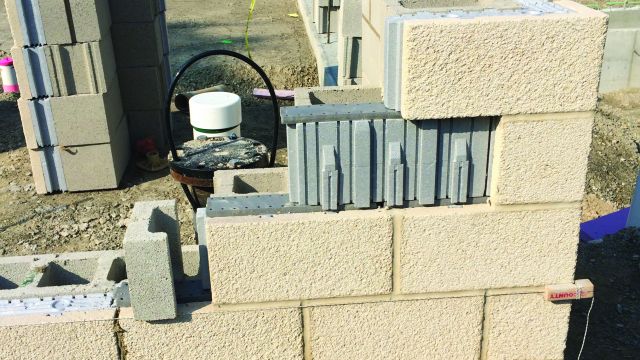Moisture Management’s Front Line
Construction pros can help prevent moisture buildup with a system-based approach
By Jim Cooper
Advancements in building technologies have produced both lighter-weight materials that help reduce initial construction costs and the ability to create tighter building envelopes, which can lower lifetime energy costs. As beneficial as these overall savings are, using such technologies poses the potential for moisture damage and associated costs down the road. Fortunately, the right combination of building technologies, products and installation techniques can net the benefits of efficiency and economics while also protecting against moisture damage.
Moisture or water vapor moves in and out of a building with air currents, by diffusion through the building’s materials, and through heat transfer. A building’s first line of defense is its exterior wall. Here, masonry is an excellent choice for moisture control, as long as it is installed in such a way as to both prevent the infiltration of water, and direct any water that does penetrate down the exterior cavity of the building.
Different masonry types will require different installation and moisture management techniques, but in general the National Concrete Masonry Association (NCMA) recommends the use of: flashing and counter-flashing, weeps, vents, sealants, water repellants, post-applied surface treatments, vapor retarders and crack control measures. The association also points to redundancy of components so the wall will remain watertight even if one of the systems fails.
One way to reduce the number of steps and materials necessary to achieve moisture control is for designers and builders to consider using properly detailed single-wythe walls. These eliminate the need for a cavity wall as backup. Most contain an integral water repellant (IWR), drainable cores and an interior face shell. Used with flashing and weeps and a post-applied water repellant, they can keep moisture out of the interior envelope.
Another way to install masonry while incorporating redundant moisture management strategies is by using complete masonry systems. These combine structures that more easily transport water vapor to minimize mold, mildew and potential structural damage and incorporate stainless steel ties that won’t rust or corrode, as well as drainage channels that send water down and away from the building. These systems also may be easier to install because they already combine many products into one.
Also important is the use of a proper ventilation system and avoidance of materials that aid in the growth of bacteria and mold, such as organic and paper-based products and wall-to-wall carpeting.
Water repellants, which are added to both manufactured stone veneers and mortar, are another high-performance solution for controlling moisture. Water-repellant admixtures are an integral part of a building’s moisture control strategy. They enhance other technologies that direct moisture down and away from a building by working to control the penetration of moisture in the first place.
Various water repellants can be applied to mortar or block, either at the jobsite or during production. However, jobsite applications have some limitations, including a surface life that averages two to seven years and the fact that they usually require applying two coats, which can cut into time and budget. Additionally, jobsite applications are subject to human error and nature’s wrath: if the blocks become wet prior to sealing, there could be future moisture issues. A complete moisture management solution should include the final step of sealing after the building’s completion.
On the other hand, IWRs or admixtures, such as the RainBloc System, are applied during the production of the mortar and/or block and are therefore factory controlled. They leave no surface film, won’t wear or wash off, and the masonry is breathable. Integrated water repellants are particularly effective in lightweight concrete masonry units and in single-wythe walls, where additional protection against water and wind-driven rain is needed.
For maximum benefit or extreme conditions, consider using block and mortar with integrated and applied water repellants together.
By using systems that combine water-resistant materials and technology to direct moisture down and away from the building, construction and masonry professionals can help safeguard their clients’ investments — and health — from the damaging effects of moisture.
About the Author
Jim Cooper is a national sales manager for Echelon Masonry. A seasoned veteran of the manufactured stone industry, he currently oversees the Echelon Artisan series along with national accounts from his home base in Minnesota.



















